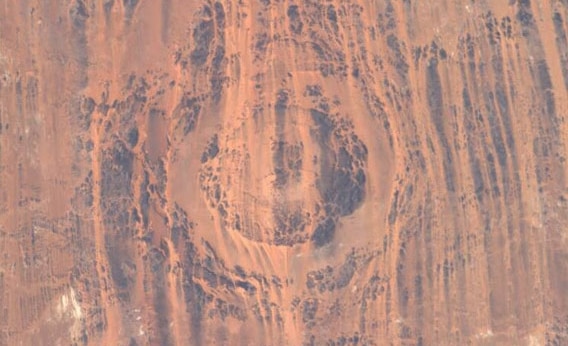Create a free profile to get unlimited access to exclusive videos, sweepstakes, and more!
A Crater Seen from Space…But Which Is It?

Luca Parmitano is an Italian astronaut whoâs been on the International Space Station since May 2013. Heâs been taking lots of pictures from space, and on Friday morning, June 21, 2013, he tweeted an interesting one:
The picture linked in his tweet was this:
Cool, eh? [Note: I cropped it, upped the contrast a bit to it to make it more clear, and rotated it so north is more toward the top.] I missed Parmitanoâs first tweet, but then he followed up with this:
That piqued my curiosity, so I looked up his earlier tweet and saw the weird formation. I recognized it right away, and after a quick Google search to make sure I got the spelling correct, I sent a note back:
That is indeed the Aorounga crater, located in north Chad. I poked around on Wolfram Alpha and discovered that at 11:55 UTC on June 21, 2013, the ISS was only a couple of hundred kilometers from the crater, so that seems like about the right time. In fact, the ISS was over the Libya/Chad/Niger border, so Iâm guessing thatâs when he took the picture.
The crater is about 12 kilometers (8 miles) across, though in this picture the complete extent isnât obvious. Usually itâs hard to know how old a crater is, but this one clearly deformed the striations of sedimentary rock around it, and that rock is roughly 350 million years old. So it must be younger than that.
The crater is oddly structured. There is a central peak or mound, surrounded by a circular trough (which is difficult to see in this picture but more obvious here), then a thicker annulus of raised terrain around that, and then another annular trough. Multiple rings like this are common in large impacts, though usually the rings arenât this thick. Also, the crater is rather small to show such complex structure; maybe it has something to do with the composition of the surface into which the asteroid impacted.
The long lines in the rock are actually erosion features due to wind, which blows steadily from the northeast (north is to the upper left in this picture). Those carve the rock into elongated ridges called yardangs. Sand has blown into the grooves between them, creating the color and shading contrast.
Interestinglyâthough everything about impact craters is interesting!âthis crater may be one of three impacts that happened at the same time. The other two are nearby but not as obvious; theyâve been filled by sand and were detected using radar observations from space. Multiple impacts can happen when an asteroid has a moon or moons, though the similar sizes of the three craters implies all three bodies were about the same size. Maybe it was one big rock that broke apart as it rammed through our air.
At the time I write this, I donât know if Parmitano saw my tweet (or some others that also indicated what the crater is), but itâs fun to think he might. Traveling over Earth at 8 kilometers per second, it must be incredibly hard to identify some of the features below when youâre above them in real time. But instant communication through social media can help, at least sometimes. The crowd mind does have its advantages.
[UPDATE (June 23 at 16:20 UTC): He saw it! He +1ed my post on Google+:
Â
Wow. Thanks, Luca!]














